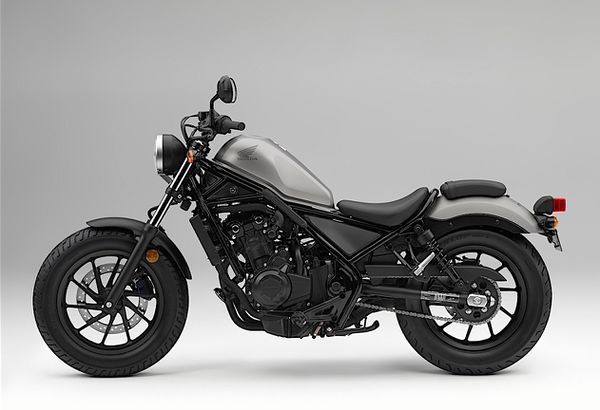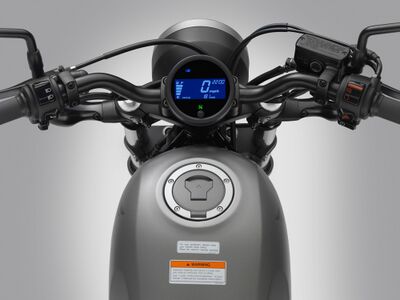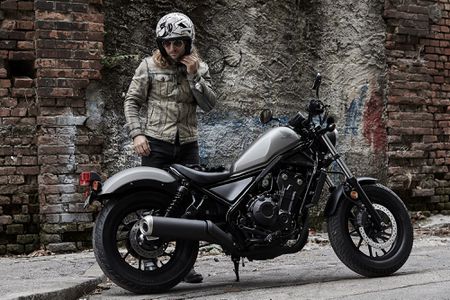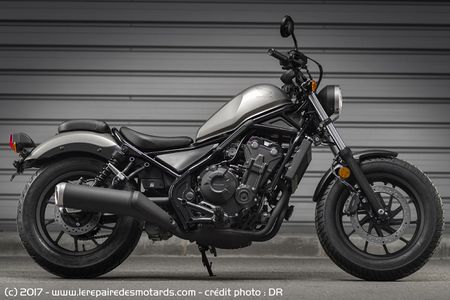Difference between revisions of "Honda CMX500 Rebel"
m |
m |
||
| Line 1: | Line 1: | ||
{{DISPLAYTITLE: Honda Rebel 500 (CMX500)}} | {{DISPLAYTITLE: Honda Rebel 500 (CMX500)}} | ||
| + | {{#seo: | ||
| + | |keywords={{PAGENAME}}, review, specs, owners manual, service manual, guide | ||
| + | |og:image=https://en.enduro.team/images/4/44/Rebel4.jpg | ||
| + | }} | ||
__notoc__ | __notoc__ | ||
[[file: Rebel4.jpg | 600px | center | Honda Rebel 500]] | [[file: Rebel4.jpg | 600px | center | Honda Rebel 500]] | ||
Latest revision as of 13:54, 27 June 2023
The cruiser model ' Honda Rebel 500 was presented in 2016 along with the younger version Honda Rebel 300 in 2016 at the IMS show. Both models have replaced the obsolete Honda Rebel 250, which has been produced practically unchanged since 1985. Official sales of the Honda Rebel 500 began in 2017.
The Honda Rebel 500 is based on a liquid-cooled, in-line 2-cylinder engine found in Honda CB500F, Honda CB500X and Honda CBR500R, retuned to increase torque on the "bottoms" and reducing the maximum working speed. As a result, the engine began to produce about 45 hp. power and 44.5 Nm of torque. The younger version Honda Rebel 300 differs in that it is built on the basis of a 1-cylinder engine from Honda CBR300R, otherwise both versions are identical.
Compared to the Honda Rebel 250, the new version of the Honda Rebel 500 receives a number of technical and visual differences. Firstly, the appearance of the motorcycle has the features of a bobber. Secondly, the spoked wheels were replaced with cast ones. Thirdly, there is practically no chrome left in the motorcycle - instead of it, the parts are covered with matte black paint. Fourth, the classic analogue instrument cluster has been replaced by a fully electronic one.
On the technical side, the new motorcycle also has a number of radical differences. First, the engine increased its volume to 500 cc. see, became an in-line twin with liquid cooling and electronic fuel injection. Secondly, the classic 5-speed gearbox has been replaced with a 6-speed one. Thirdly, the braking system is now fully disc braking with the possibility of equipping with ABS.
From the additional equipment of the Honda Rebel 500, in addition to ABS, it is possible to order passenger footpegs, a saddle, luggage accessories and a windshield.
Photos
Specifications
Specifications Honda Rebel 500:
| Model | Honda Rebel 500 |
|---|---|
| Motorcycle type | cruiser |
| Release year | 2017+ |
| Frame | steel tubular |
| Engine type | 2-cylinder, 4-stroke, in-line |
| Working volume | 471 cm³ |
| Bore / stroke | 67.0 x 66.8mm |
| Compression ratio | 10.7: 1 |
| Cooling | liquid |
| Number of valves per cylinder | DOHC, 4 valves per cylinder |
| Fuel supply system | PGM-FI injector, 2x 34 mm |
| Ignition type | digital transistor |
| Maximum power | 45.5 h.p. (33.5 kW) at 8500 rpm |
| Maximum torque | 44.6 Nm (4.5 kgm) at 6000 rpm |
| Gearbox | 6-speed |
| Drive type | chain |
| Front tire size | 130 / 90-16M / C 67H |
| Rear tire size | 150 / 80-16M / C 71H |
| Front brakes | 1 disc 296 mm, 2-piston caliper (ABS opt.) |
| Rear brakes | 1 disc 240 mm, 1-piston caliper (ABS opt.) |
| Front suspension | 41mm Telescopic Fork (Fixed), 121mm Travel |
| Rear suspension | linkage with two shock absorbers (adjustable preload), stroke - 95 mm |
| Length | 2188 mm |
| Width | 820 mm |
| Height | 1094 mm |
| Wheelbase | 1488 mm |
| Saddle height | 690 mm |
| Minimum ground clearance | 136 mm |
| Acceleration to 100 km / h | 5.9 sec |
| Maximum speed | 170 km / h |
| Fuel tank capacity | 11.2 l |
| Motorcycle weight (curb) | 185 kg - Honda Rebel 500
190 kg - Honda Rebel 500 (ABS) |
Fuel consumption
The officially declared fuel consumption of the Honda CMX500 Rebel is 3.86 liters per 100 kilometers. The exact value depends on the riding style.



